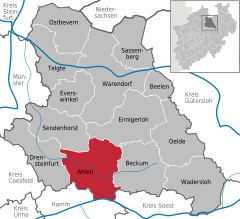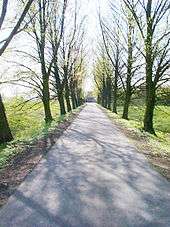Ahlen
| Ahlen | ||
|---|---|---|
|
St. Marien Church | ||
| ||
 Ahlen | ||
Location of Ahlen within Warendorf district 
 | ||
| Coordinates: 51°45′48″N 7°53′28″E / 51.76333°N 7.89111°ECoordinates: 51°45′48″N 7°53′28″E / 51.76333°N 7.89111°E | ||
| Country | Germany | |
| State | North Rhine-Westphalia | |
| Admin. region | Münster | |
| District | Warendorf | |
| Government | ||
| • Mayor | Dr. Alexander Berger (without party) | |
| Area | ||
| • Total | 123.14 km2 (47.54 sq mi) | |
| Population (2015-12-31)[1] | ||
| • Total | 52,287 | |
| • Density | 420/km2 (1,100/sq mi) | |
| Time zone | CET/CEST (UTC+1/+2) | |
| Postal codes | 59227, 59229 | |
| Dialling codes | 02382, 02388, 02528 | |
| Vehicle registration | WAF | |
| Website | www.ahlen.de | |
Ahlen (German pronunciation: [ˈaːlən]; Westphalian: Aulen) is a town in North Rhine-Westphalia, Germany. It is part of the District of Warendorf and is economically the most important town in that district. Ahlen is part of the larger Münster region, and of the historic Münsterland area. The nearby villages of Dolberg, Vorhelm and Tönnishäuschen are part of Ahlen, as well. The largest neighboring town is the city of Hamm to the southwest.
Geography
Neighbouring Towns
Surrounding Ahlen are the towns of Sendenhorst, Ennigerloh, Beckum, Lippetal, Heessen (District of the city of Hamm) and Drensteinfurt.
Town Districts
- Ahlen (downtown) with the farming communities of Borbein, Brockhausen, Ester, Halene, Oestrich and Rosendahl (area of the former town parts of Alt- and Neuahlen) all make up the core of the town.
Outlying Villages
- Dolberg
- Vorhelm
- Tönnishäuschen
History
Early Times
Ahlen was first uttered in the Vita Liudgeri II in or about the year 850. Grounds for the name Ahlen, which indeed means "eels", are unknown. A bedecked eel with a crown and feathers fittingly dons the town's coat of arms. The start of the settlement was likely due to there being a crossing over the river Werse, which was also the crossing of two key roads (Hamm–Ahlen–Warendorf and Beckum–Ahlen–Herbern), and the beginning of a third road (Ahlen–Münster). In its early centuries, the fledgling settlement was built around an episcopal court. Within the safe haven of this church fortification, the first settlers were craftsmen and merchants who traded with the local farmers and peasants of the court. Long-distance trading started in the second half of the 12th century — proof being the names of Ahlen merchants found on invoices from merchants in Lübeck. Ahlen was also part of the north German Hanse. During this time a town wall with five towers was built (about 1271). The stripping away of the town wall had begun in the year 1765 and the last hint of it was gone by 1929.




Ahlen grew quickly during the 13th century and in or about the year 1285, the population was so high that a new church (St. Marien) was founded next to the old one (St. Bartholomäus). This leads to the likelihood that Ahlen was one of the 18 biggest towns in Westphalia, at that time. However, the town's growth was hindered in the 14th century by the Black Death. According to the town's census book of 1389, only 63 families were left in Ahlen. But the town rebounded. In 1454, a citizen list showed 212 families living in Ahlen; seven noble families and their attendants lived in the episcopal court as well. Based on this number of families, a calculated population estimate of 1,300 citizens would be realistic. By this time the town had four quarters — all of which being about the same size and each quarter being named after its own town gate. Each quarter was responsible for defending its part of the town wall and gate.
During the 16th century, there were three plague epidemics in 1505, 1551 and 1592; leprosy also killed many people. In the year 1571, the mayor and the council decided to build a special hospital for leprosy. Disastrous fires in 1483, 1668 and 1744 were responsible for further halting Ahlen's growth.
About 20 documents of witch trials during the time from 1574 until 1652 survive. The hunt for witches started in 1574 with the death of four women. Thereafter, Peter Kleikamp was charged with being a werewolf; he was tortured and burned alive on the pyre. In 1616, Christian zum Loe was charged with wizardry; he went insane and died while in jail. The last known case was in 1652 against Anna Sadelers; she was tortured, burned alive on the pyre and beheaded.
Politics
Town Council
| Party | Result of election |
|---|---|
| CDU | 50,94% (−1,3 Points) |
| SPD | 35,36% (−5,5 Points) |
| Grüne | 8,12% (+3,9 Points) |
| FDP | 5,58% (+3,0 Points) |
Sister Cities
Partnerships are set with the following towns:
- Tempelhof-Schöneberg, Berlin, Germany
- Teltow, Brandenburg, Germany
- Penzberg, Bavaria, Germany
- Differdange (Differdingen), Luxembourg
Ahlen is member of the Hanse.
Mayors
1809–1945
- 1809–1813 Bernard Heinrich Hahues
- 1813–1817 Bernard Anton von Hatzfeld
- 1817–1822 Heinrich Anton Nacke
- 1823–1856 Franz Wächter
- 1857–1863 Theodor von Cloedt
- 1863–1869 Wilhelm Diederich
- 1869–1870 Ludwig Fry
- 1870–1898 Johann Heinrich Hagemann
- 1898–1923 Eduard Corneli
- 1923–1934 Georg Rasche
- 1934–1937 Franz Hackethal
- 1938–1945 Otto Jansen
Honorary Mayors 1946–1996
- 1946–1946 Friedrich Niemeyer
- 1946–1948 Hermann Dreisilker (Waldmann)
- 1948–1950 Hugo Stoffers
- 1951–1957 Heinrich Lenfert
- 1957–1969 Heinrich Linnemann
- 1969–1984 Herbert Faust
- 1984–1996 Horst Jaunich
Full-time Mayors since 1996
- 1996–1999 Günter Harms
- since 1999 Benedikt Ruhmöller
Town Directors/Main Civil Servants
- 1945–1945 Wilhelm Buschhoff (set as mayor from English occupying troops in the function as town director)
- 1945–1951 Wilhelm Kiwit
- 1951–1963 Hugo Stoffers
- 1963–1975 Johannes Baldauf
- 1975–1985 Walter Priesnitz
- 1985–1995 Gerd Willamowski
- 2008 Benedikt Ruhmöller
Economy and Administration
Business
One of the best known companies in Ahlen is Franz Kaldewei GmbH & Co. KG, one of the biggest bathtub manufacturers worldwide. Also well known is LR Health & Beauty Systems,[3] which was bought by Apax Partners in 2004.
Transportation
Railroad Transport
Ahlen station is on the Hamm–Minden railway and is served every hour by the Westfalen-Express and the Ems-Börde-Bahn.
Education
Elementary Schools
- Albert-Schweitzer-Schule
- Augustin-Wibbelt-Schule in the quarter Vorhelm
- Barbaraschule
- Diesterwegschule
- Don-Bosco-Schule
- Freiligrath Grundschule
- Lambertischule in the quarter Dolberg
- Ludgerischule
- Marienschule
- Martinschule
- Paul-Gerhardt-Schule
Secondary Modern Schools
- GHS Bodelschwinghschule
- Overbergschule
- Geschwister-Scholl-Schule
Junior High School (ages 10 to 16)
- Städtische Realschule Ahlen
High schools
- Gymnasium St. Michael
- Städtisches Gymnasium Ahlen
Comprehensive School
- Fritz-Winter-Gesamtschule
Special Needs School
- Johanna-Rose-Schule
Vocational Schools
- Berufskolleg Ahlen
- Berufskolleg St. Michael[4]
- Fachschulen für Heilerziehungspflege der Caritas-Trägergesellschaft Nord
- Fachseminar für Altenpflege Gemeinnütziges Bildungszentrum GmbH
- Krankenpflegeschule im St.-Franziskus-Hospital Berufskolleg Ahlen
Places of interest
Buildings
- St. Bartholomäus Catholic Church
- St. Marien Catholic Church
- Residential Buildings
- Burgmannshöfe
- Ahlen Water Tower
Museums
- Heimatmuseum
- Kunstmuseum
- Fritz Winter-Haus
Clubs
- KunstVerein Ahlen
- Initiative Bürgerzentrum Schuhfabrik e.V.
Economy
Ahlen's economy was dominated by the coal industry for nearly one century.
Notable people
- Birthplace of former Valencia CF footballer, Curro Torres.
- The Pagan Black Metal band Heimdalls Wacht hail from Ahlen.
- LaVive's band member Sarah Rensing is from Ahlen as well.
- Prof Dr Andreas Dombret, Board member of German central bank Deutsche Bundesbank, grew up in Ahlen.
- Erkan Teper, professional boxer
References
- ↑ "Amtliche Bevölkerungszahlen". Landesbetrieb Information und Technik NRW (in German). 18 July 2016.
- ↑ Gallery of myors in the old town hall 1809–1996, by Jürgen Rheker
- ↑ Lrworld.com
- ↑ Berufskolleg-st-michael.de
External links
| Wikimedia Commons has media related to Ahlen. |
- Official site (German)
